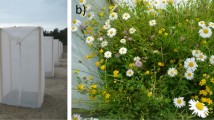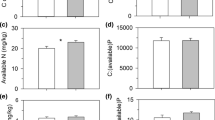Abstract
Resource availability may influence invertebrate communities, with important consequences for ecosystem function, such as biomass production. We assessed: (1) the effects of experimental soil nutrient additions on invertebrate abundances and feeding rates and (2) the resultant changes in the effects of invertebrates on aboveground plant biomass at three grassland sites spanning the North American Central Plains, across which plant tissue chemistry and biomass vary. Invertebrate communities and rates of herbivory were sampled within a long-term nutrient-addition experiment established at each site along the broad Central Plains precipitation gradient. Additionally, the effects of invertebrates on aboveground plant biomass were determined under ambient and elevated nutrient conditions. At the more mesic sites, invertebrate herbivore abundances increased and their per capita rate of herbivory decreased with nutrient additions. In contrast, at the semi-arid site where plant biomass is low and plant nutrient concentrations are high, invertebrate herbivore abundances did not vary and per capita rates of herbivory increased with nutrient additions. No change in the effect of invertebrate herbivores on aboveground plant biomass was observed at any of the sites. In sum, nutrient additions induced shifts in both plant biomass and leaf nutrient content, which altered invertebrate abundances and feeding rate. However, due to the inverse relationship between changes in herbivore abundance and per capita rates of herbivory, nutrient additions did not alter the effect of invertebrates on aboveground biomass. Overall, we suggest that this inverse response of herbivore abundance and per capita feeding rate may buffer ecosystems against changes in invertebrate damage in response to fluctuations in nutrient levels.




Similar content being viewed by others
References
Adler PB, Levine JM (2007) Contrasting relationships between precipitation and species richness in space and time. Oikos 116:221–232
Agrawal AA, Fishbein M (2006) Plant defense syndromes. Ecology 87:S132–S149
Anderson MJ (2001) A new method for non-parametric multivariate analysis of variance. Austral Ecol 26:32–46
Anderson MJ (2005) Permutational multivariate analysis of variance
Anderson MJ (2006) Distance-based tests for homogeneity of multivariate dispersions. Biometrics 62:245–253. doi:10.1111/j.1541-0420.2005.00440.x
Behmer ST (2009) Insect herbivore nutrient regulation. Annu Rev Entomol 54:165–187. doi:10.1146/annurev.ento.54.110807.090537
Behmer ST, Joern A (1993) Diet choice by a grass-feeding grasshopper based on the need for a limiting nutrient. Funct Ecol 7:522–527
Behmer ST, Joern A (2008) Coexisting generalist herbivores occupy unique nutritional feeding niches. Proc Natl Acad Sci 105:1977–1982. doi:10.1073/pnas.0711870105
Berner D, Blanckenhorn WU, Korner C (2005) Grasshoppers cope with low host plant quality by compensatory feeding and food selection: N limitation challenged. Oikos 111:525–533
Blue JD, Souza L, Classen AT, Schweitzer JA, Sanders NJ (2011) The variable effects of soil nitrogen availability and insect herbivory on aboveground and belowground plant biomass in an old-field ecosystem. Oecologia 167:771–780. doi:10.1007/s00442-011-2028-7
Borer ET, Seabloom EW, Shurin JB, Anderson K, Blanchette CA, Broitman B, Cooper SD, Halpern BS (2005) What determines the strength of a trophic cascade? Ecology 86:528–537
Borer ET, Seabloom EW, Tilman D, Novotny V (2012) Plant diversity controls arthropod biomass and temporal stability. Ecol Lett 15:1457–1464. doi:10.1111/ele.12006
Borer ET, Seabloom EW, Gruner DS, Harpole WS, Hillebrand H et al (2014) Herbivores and nutrients control grassland plant diversity via light limitation. Nature 508:517–520. doi:10.1038/nature13144
Burnham KP (2004) Multimodel inference: understanding AIC and BIC in model selection. Sociol Methods Res 33:261–304. doi:10.1177/0049124104268644
Chambers P, Simpson SJ, Raubenheimer D (1995) Behavioural mechanisms of nutrient balancing in Locusta migratoria nymphs. Anim Behav 50:1513–1523
Chapin FS, Autumn K, Pugnaire F (1993) Evolution of suites of traits in response to environmental stress. Am Nat 142:S78–S92
Chase JM, Leibold MA, Downing AL, Shurin JB (2000) The effects of productivity, herbivory, and plant species turnover in grassland food webs. Ecology 81:2485–2497
Chen Y, Olson DM, Ruberson JR (2010) Effects of nitrogen fertilization on tritrophic interactions. Arthropod Plant Interact 4:81–94. doi:10.1007/s11829-010-9092-5
Cleland EE, Harpole WS (2010) Nitrogen enrichment and plant communities. Year in ecology and conservation biology 2010. Blackwell, Oxford, pp 46–61
Cleland EE, Peters HA, Mooney HA, Field CB (2006) Gastropod herbivory in response to elevated CO2 and N addition impacts plant community composition. Ecology 87:686–694
Coffin DP, Laycock WA, Lauenroth WK (1998) Disturbance intensity and above- and belowground herbivory effects on long-term (14 y) recovery of a semiarid grassland. Plant Ecol 139:221–233
Coley PD, Bryant JP, Chapin FS (1985) Resource availability and plant antiherbivore defense. Science 230:895–899. doi:10.1126/science.230.4728.895
Cronin JP, Tonsor SJ, Carson WP (2010) A simultaneous test of trophic interaction models: which vegetation characteristic explains herbivore control over plant community mass? Ecol Lett 13:202–212. doi:10.1111/j.1461-0248.2009.01420.x
De Sassi C, Staniczenko PPA, Tylianakis JM (2012) Warming and nitrogen affect size structuring and density dependence in a host-parasitoid food web. Philos Trans R Soc Lond B Biol Sci 367:3033–3041. doi:10.1098/rstb.2012.0233
Denno RF, Fagan W (2003) Might nitrogen limitation promote omnivory among carnivorous arthropods? Ecology 84:2522–2531
Denno RF, Gratton C, Peterson M (2002) Bottom-up forces mediate natural-enemy impact in a phytophagous insect community. Ecology 83:1443–1458
Duffy JE, Cardinale BJ, France KE, McIntyre PB, Thébault E, Loreau M (2007) The functional role of biodiversity in ecosystems: incorporating trophic complexity. Ecol Lett 10:522–538. doi:10.1111/j.1461-0248.2007.01037.x
Elser JJ, Sterner RW, Gorokhova E, Fagan WF, Markow TA, Cotner JB, Harrison JF, Hobbie SE, Odell GM, Weider LW (2000a) Biological stoichiometry from genes to ecosystems. Ecol Lett 3:540–550. doi:10.1046/j.1461-0248.2000.00185.x
Elser JJ, Fagan WF, Denno RF, Dobberfuhl DR, Folarin A, Huberty A, Interlandi S, Kilham SS, McCauley E, Schulz KL, Siemann EH, Sterner RW (2000b) Nutritional constraints in terrestrial and freshwater food webs. Nature 408:578–580
Fagan WF, Siemann E, Mitter C, Denno RF, Huberty AF, Woods HA, Elser JJ (2002) Nitrogen in insects: implications for trophic complexity and species diversification. Am Nat 160:784–802
Fink P, von Elert E (2006) Physiological responses to stoichiometric constraints: nutrient limitation and compensatory feeding in a freshwater snail. Oikos 115:484–494
Forkner RE, Hunter MD (2000) What goes up must come down? Nutrient addition and predation pressure on oak herbivores. Ecology 81:1588. doi:10.2307/177309
Haddad NM, Crutsinger GM, Gross K, Haarstad J, Knops JMH, Tilman D (2009) Plant species loss decreases arthropod diversity and shifts trophic structure. Ecol Lett 12:1029–1039
Hall SR (2009) Stoichiometrically explicit food webs: feedbacks between resource supply, elemental constraints, and species diversity. Annu Rev Ecol Evol Syst 40:503–528. doi:10.1146/annurev.ecolsys.39.110707.173518
Hall SR, Knight CJ, Becker CR, Duffy MA, Tessier AJ, Cáceres CE (2009) Quality matters: resource quality for hosts and the timing of epidemics. Ecol Lett 12:118–128. doi:10.1111/j.1461-0248.2008.01264.x
Hartley MK, Rogers WE, Siemann E, Grace JB (2007) Responses of prairie arthropod communities to fire and fertilizer: balancing plant and arthropod conservation. Am Midl Nat 157:92–105
Huxel GR (1999) On the influence of food quality in consumer-resource interactions. Ecol Lett 2:256–261
Joern A, Behmer ST (1998) Impact of diet quality on demographic attributes in adult grasshoppers and the nitrogen limitation hypothesis. Ecol Entomol 23:174–184
Knapp AK, Briggs JM, Hartnett DC, Collins SL (eds) (1998) Grassland dynamics. Oxford University Press, New York
La Pierre KJ, Joern A, Smith MD (2015) Invertebrate, not small vertebrate, herbivory interacts with nutrient availability to impact tallgrass prairie community composition and forb biomass. Oikos. doi:10.1111/oik.01869
Lauenroth WK, Burke IC (eds) (2008) Ecology of the shortgrass steppe: a long-term perspective. Oxford University Press, Oxford
Loaiza V, Jonas JL, Joern A (2008) Does dietary P affect feeding and performance in the mixed-feeding grasshopper, (Acrididae) Melanoplus bivitattus? Environ Entomol 37:333–339
Loaiza V, Jonas JL, Joern A (2011) Grasshoppers (Orthoptera: Acrididae) select vegetation patches in local-scale responses to foliar nitrogen but not phosphorus in native grassland. Insect Sci 18:533–540. doi:10.1111/j.1744-7917.2010.01376.x
Mattson WJ (1980) Herbivory in relation to plant nitrogen content. Annu Rev Ecol Syst 11:119–161. doi:10.1146/annurev.es.11.110180.001003
McCulley R, Burke IC, Lauenroth WK (2009) Conservation of nitrogen increases with precipitation across a major grassland gradient in the Central Great Plains of North America. Oecologia 159:571–581. doi:10.1007/s00442-008-1229-1
Milchunas DG, Sala OE, Lauenroth WK (1988) A generalized-model of the effects of grazing by large herbivores on grassland community structure. Am Nat 132:87–106
Milchunas DG, Lauenroth WK, Chapman PL, Kazempour MK (1990) Community attributes along a perturbation gradient in a shortgrass steppe. J Veg Sci 1:375–384
Oedekoven MA, Joern A (2000) Plant quality and spider predation affects grasshoppers (Acrididae): food-quality-dependent compensatory mortality. Ecology 81:66–77
Risser PG, Birney EC, Blocker HD, May SW, Parton WJ, Wins JA (eds) (1981) The true prairie ecosystem. Hutchinson Ross, Stroudsburg
Schmitz OJ (2003) Top predator control of plant biodiversity and productivity in an old-field ecosystem. Ecol Lett 6:156–163
Schmitz OJ (2008a) Effects of predator hunting mode on grassland ecosystem function. Science 319:952–954. doi:10.1126/science.1152355
Schmitz OJ (2008b) Herbivory from individuals to ecosystems. Annu Rev Ecol Evol Syst 39:133–152. doi:10.1146/annurev.ecolsys.39.110707.173418
Siemann E (1998) Experimental tests of effects of plant productivity and diversity on grassland arthropod diversity. Ecology 79:2057–2070
Sterner R, Elser JJ, Hessen D (1992) Stoichiometric relationships among producers, consumers and nutrient cycling in pelagic ecosystems. Biogeochemistry 17:49–67
Throop HL, Lerdau M (2004) Effects of nitrogen deposition on insect herbivory: implications for community and ecosystem processes. Ecosystems 7:109–133. doi:10.1007/s10021-003-0225-x
Whiles MR, Charlton RE (2006) The ecological significance of tallgrass prairie arthropods. Annu Rev Entomol 51:387–412
Acknowledgments
The authors are grateful for field assistance from M. Avolio, D. Blumenthal, C. Brown, L. Dev, K. Harmony, J. Klein, A. Kuhl, B. La Pierre, A. Potter, R. Ramundo, A. Joern, and the SGS field crew. O. Schmitz, K. Gross, K. Burghardt, and three anonymous reviewers provided helpful feedback on earlier drafts of the manuscript. Funding was provided by a Yale Institute for Biospheric Studies Center for Field Ecology Pilot Grant, a Yale Institute for Biospheric Studies Dissertation Improvement Grant, and a grant from the Lee Pierce Fund to K. La Pierre, the Konza Prairie LTER, and the Shortgrass Steppe LTER. This work was generated using data from three sites within the Nutrient Network collaborative experiment, funded at the site scale by individual researchers and coordinated through Research Coordination Network funding from the National Science Foundation to E. Borer and E. Seabloom (NSF-DEB-1042132). N fertilizer was donated by Crop Production Services, Loveland, Colorado. K. La Pierre was supported by an National Science Foundation Graduate Research Fellowship.
Author contribution statement
K. J. L. and M. D. S. conceived and designed the experiments. K. J. L. performed the experiments and analyzed the data. K. J. L. wrote the manuscript with editorial input from M. D. S.
Author information
Authors and Affiliations
Corresponding author
Additional information
Communicated by Andreas Prinzing.
Electronic supplementary material
Below is the link to the electronic supplementary material.
Rights and permissions
About this article
Cite this article
La Pierre, K.J., Smith, M.D. Soil nutrient additions increase invertebrate herbivore abundances, but not herbivory, across three grassland systems. Oecologia 180, 485–497 (2016). https://doi.org/10.1007/s00442-015-3471-7
Received:
Accepted:
Published:
Issue Date:
DOI: https://doi.org/10.1007/s00442-015-3471-7




